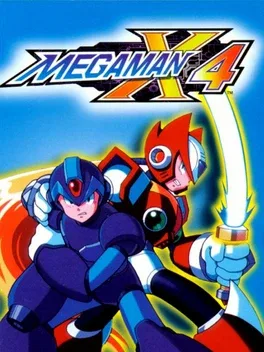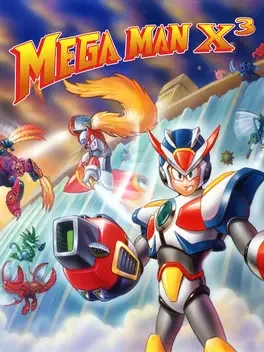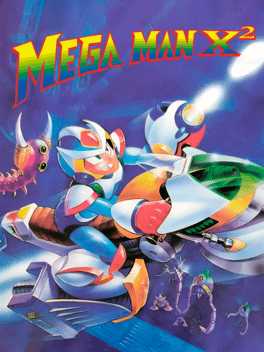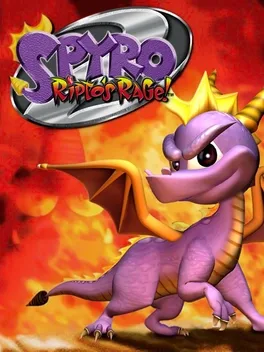(Originally published to Glitchwave on 1/9/2025)
[Image from glitchwave.com]
Mega Man 7
Developer: Capcom
Publisher: Capcom
Genre(s): 2D Platformer
Platforms: SNES
Release Date: May 24, 1995
Does Capcom mean to tell us with Mega Man 7 that Mega Man X WASN’T intended to be the changing of the guard into the next generation? Are they really pushing their shitty 1995 Buick Roadmaster up a hilly country road when it’s out of gas after they’ve purchased a strapping new automobile that’s completely fueled up? Is it sentimentalism that keeps Capcom from pulling the plug on the original Mega Man series, a sextet of NES titles that were beaten into a vegetative state of creative burnout due to oversaturation? Did they really think that shifting the series to a console that doubled the visual capacity with a seventh entry would make a difference? Whatever the impetus was, digging up the classic Mega Man series that was presumably dead when Mega Man X hit the scene has me befuddled to Hell and back. Coexisting alongside its evolved descendant like how monkeys still roam the Earth after we humans still reign supreme is a nice gesture, but what exactly can the classic series do to prove that the X series hasn’t condemned it to obsolescence? It doesn’t help that Mega Man 7 is not a particularly well-regarded entry to the classic series, so the case for its continued lifespan isn’t holding up all that well. However, even though it doesn’t hold a candle to the highest points of the X series, I’ve found that Mega Man 7’s ill-repute among its classic series peers can be heavily disputed.
Simply because Mega Man 7 shares a kinship with the primitive classic series doesn’t mean it’s restricted to sharing their 8-bit modesty. Due to existing on the same 16-bit system, Mega Man 7 borrows an abundance of presentational flair from Mega Man X. This is immediately apparent when the game begins with a cutscene sequence that sees Mega Man having a conversation with Roll and a new character named Auto, complete with scrolling text on screen contained in speech bubbles. Once the conversation stops, Mega Man is thrusted into the chaos on the futuristic city streets in a prologue level, an introductory standard stripped from the X sub-series. While the cinematic touches and expositional sequence put it on a relatively equal standing in narrative richness to any of the X games, Mega Man 7 does not choose to channel the sharper, slightly more mature aesthetic of the classic series’ offspring. Mega Man 7 still exists in the same timeline as the unrefined NES games with the same diminutive robot boy seen a century before Dr. Light advanced his darling automaton with that extra X chromosome, so the aesthetic needed to reflect the jejune status of our hero that we likely forgot since the first X game was released. The result of this consideration is a bright and colorful aesthetic akin to the lightheartedness of a Saturday morning cartoon, with the 16-bit graphics of the NES animating the pixel art to a discernible degree. As for Mega Man’s design, the developers found it essential for him to share that look of passionate, heroic determination as his X alter ego. In execution, the boyish baby fat of Mega Man’s face makes his serious visage resemble that of an annoyed Butters from South Park. It makes me want to give Mega Man a noogie, not treat him seriously as the savior of the cyber age.
Other than the animated visual overhaul and the marginal strides to elevate the narrative to be on par with the X games, Mega Man 7 is predictably the same old song and dance as any other Mega Man game. Eight robot masters must be vanquished and their powers will be downloaded into Mega Man’s all-purpose arm cannon, and checking them all off on the blue bomber’s hit list will unlock Wily’s fortress where Mega Man will confront the mustachioed menace. However, one change to the series’ formulaic arc found here is that only half of the robot master roster is available at the start. The opening cutscene explains what seems like an arbitrary, insignificant monkey wrench into a Mega Man tradition, in that only four robot masters beckoned to Dr. Wily’s command to tear up the city brick by brick if he did not make his presence known for six months (on account of being incarcerated). On one hand, only offering half of the lineup initially severely limits the possibilities of the progression trajectory. On the other hand, I suppose that the suppressed selection connotes that finding one of these robot masters’ weaknesses is a one-and-three chance instead of the usual one-and-seven, so the suggested progression course is quicker and easier to start.
Once the player finds the intended trajectory, they’ll find that Mega Man 7’s levels are perfectly cromulent and outstandingly diverse as always. The rubber of Turbo Man’s spare tires will bounce Mega Man into the hazardous spike pits if he collides with their conveyor system, while the refuse of Junk Man’s stage is being collected as a shelter for groups of repugnant little robot cockroaches. Freeze Man is the exhausted, yet effective snow stage, while the Jurassic Park jungle with robotic dinosaurs that Slash Man operates prolongs a pattern of humid environments usually prevalent across every X entry. The buoyancy of the liquid physics in Burst Man’s stage and how to calculate Mega Man’s jump force in relation to how far he will sink is a genuinely clever innovation on the standard water level. The standout level in Mega Man 7 for my money is Shade Man’s, for the bat and zombie-infested Halloween town is the series’ first stab at a horror-themed area. Sue me, I’m a sucker for spookiness. As for their weapons, each of them falls nicely in the middle of the spectrum between the orgasmic bodaciousness of the Metal Blade and the pitiful, horribly conceived Top Spin. Burst Man is an advancement on Bubble Man’s conceptual identity, as his liquid globules are dense enough to ensnare enemies and lift them to the great unknown or trap them to the ceiling. Cloud Man is evidently of the cumulonimbus variation, for Mega Man can condense the power of his lightning into an energy blast the size of the charge shot. Spring Man’s coils can be charged to unleash two simultaneously, and I guess Shade Man’s sonar blast is shrill enough to warp a robot’s circuitry. Slash Man’s weapon is especially notable not only because it compensates for Mega Man’s lack of close-ranged offense, but because it looks like Mega Man is bitch slapping his enemies. Pay your respects, Dr. Wily.
Some of the common negative discourse surrounding Mega Man 7 is that the game is far too facile to uphold the blistering Mega Man standard of difficulty. I criticized Mega Man 5 for loosening the classic difficulty grip on the player, but Mega Man 7 is comparatively a brisk walk in the park. Enemy placements are reasonable, level hazards are manageable, and the stage gimmicks such as the reappearing block platforms aren’t nearly as demanding as they used to be. Truthfully, the quality-of-life enhancements are quite refreshing. The level of accessibility on display feels far more organic than when Mega Man 5 attempted to ease the pain of steep difficulty because of the refinement that comes with the advanced hardware of the SNES. The inherent upgrade in graphics and mechanics aids Mega Man 7 while Mega Man 5 felt like a deliberate digression, especially since it was released after Mega Man 4 which was the quality peak of the NES titles. It’s not to say that the fifth entry in the classic Mega Man series failed miserably on all fronts in smoothing out Mega Man’s difficulty curve, for Mega Man 7 decides to reinstate some of that game’s ideas on hardware that complimented them. Firstly, in the first four robot master stages, letters that spell RUSH are scattered somewhere in the obscured corners of the area. Mega Man veterans should recognize that these four letters form the name of Mega Man’s trusty, robotic red pooch. Mega Man will still summon Rush on occasion to trampoline him on out-of-reach platforms with his trusty coil apparatus, but all of Rush's other applications have to be found on the field like collectibles. The process of uncovering these auxiliary utilities requires the same meticulous exploration as finding any health upgrade or special abilities in an X title, and it encourages a more intimate engagement with the level along with a replayability incentive. The selection of optional gadgets obtained through exploration is also marvelously vast. For one, if the player collects all of the letters, it will unlock a combined version of both the jet and power suits seen in the previous Mega Man game, which is definitely handy during a few platforming sections in Dr Wily’s castle. Depending on how you eradicate a spherical miniboss in Shade Man’s stage that is shaped like a pumpkin, the routes its explosion unveils will lead to two separate gadgets, which will of course encourage the player to revisit the stage to unlock the one they missed on the first go-around. Finding Protoman and defeating him in a friendly duel will even warrant him anteing up his shield, blocking all pesky projectiles from grazing Mega Man. It’s such a nice gesture on his behalf that I feel obliged to send him a fruit basket as a token of my gratitude.
Protoman is so charitable to Mega Man now, figuratively giving him the shirt off his back in the shape of his shield, that one could forget that he was once his rival who formerly antagonized him at inconvenient moments. The developers figured that a new character should fill the rival role’s vacancy in the form of Bass, another humanoid robot who dons black armor instead of blue. He, along with his own canine companion, Treble, (get the reference?) makes his acquaintance with Mega Man during the prologue and states that his order of business is to stop Dr. Wily, and his assessment of Mega Man’s ability to conquer the mad scientist depends on whether or not the player can defeat him at this moment. His motives are vague, but Mega Man recognizes that Bass is fighting for the same cause and treats this mysterious stranger as a worthy ally. However, Mega Man’s naive trust in the good in his fellow robot comes to bite him in the ass when he allows Bass to recuperate from his wounds in Dr. Light’s lab. Bass ransacks the place and steals potent upgrades designed for Mega Man and Rush, and Mega Man storms Dr Wily’s castle to retrieve them. Maybe it’s just because I’m cynical to the core, but I’m not sure how effective Bass is as an antagonist. They prop him up as the classic series’ iteration of Zero, but the red rogue already had a relationship with X before the events of the game’s prologue. Establishing trust immediately without earning it is the first rule in the book of duplicity, and I wish I could express this knowledge to Mega Man before he made a fool of himself letting this jerkoff walk all over him.
However, I wish that the souped-up fusion fight with Bass and Treble was the penultimate fight of Mega Man 7, and it’s not because Dr. Wily’s fight is predictable and boring as always. Dr. Wily is evidently cross at the fact that the X series ousted him from the limelight as the series’ abiding main villain, and a scorned Wily makes for an especially spiteful encounter at the game’s climax. The first stage where Wily is hopping around in a hefty mechanical skull on stilts has a perfectly learnable attack pattern. However, the subsequent section where he’s riding around in a floating capsule fires artillery that seemingly could only be dodged with the slowed-down special effects seen in The Matrix. Wily fires four energy balls with three different kinds of elemental properties, and the suggested tactic during this boss, no joke, is to collide with the electrical ones because they deal less damage to Mega Man. Sure, one can hone their dodging prowess and evade the balls with grace and proficiency with practice, but who has time for that? To make matters worse, the capsule’s weaknesses only shave slivers off of its stocky health bar, so the player is forced to tank an inordinate amount of damage in order to survive this grueling test of endurance. Mega Man 7’s Dr. Wily is not only the definitively hardest iteration of the mad doctor, but he has joined the ranks of bosses that have angered my dentist in how they make me grit my teeth down to the pulp in frustration. It sufficiently made us all respect Wily’s authority once again, that’s for damn sure. It even aggravates Mega Man so much that he decides to forgo his laurels as he shockingly plans to execute Wily once and for all, but this decision is ultimately thwarted. Kill him, Mega Man! Paint the walls of his fortress with his blood!
While it may seem like Wily has bested us all with his zooming energy balls that have the indecipherable pattern of a swarm of flies, there is a hidden method to utilize against Wily’s unforgiving onslaught. Unless the player has the manual on hand, which I don’t, they won’t know that pressing select in the main menu will access Auto’s garage, a one-stop shop for any conceivable item in the Mega Man series. Here, Mega Man can stock up on energy and weapon tanks, and guzzling them like beer at a frat party is the only way the player will withstand Wily. Unfortunately, Mega Man can only have four of each item at a time, and insisting on buying more than the maximum allowed will cause him to be chastised by Auto for “being greedy.” Do you know what I’m up against, you fat green dope? Miserly business practices aside, the shop is a genius point of innovation. The bolt currency is plentiful and the energy tanks on the field are too sparse to rely on, so the player is more than compelled to visit this service to stand a fighting chance. Maybe check to see if the open sign is on so the player will be aware of its existence, Auto?
After several years of trusting that Mega Man 7 “sucks big dinosaur balls,” I’ve come to find that this crude assessment of the game’s quality is totally undeserved. It’s a refined Mega Man experience in all contexts. Thanks to the advancements found on the SNES, the mainline Mega Man series can flourish with colorful pixel art, greater accessibility, and more nuanced level designs that reward the player handsomely by exploring them. By borrowing assets from the X series, Mega Man 7 still doesn’t stack up to the advancements of that series because it's inherently shackled to the exhausted properties of the mainline series. Still, anyone arguing that any Mega Man game from the NES is better than this one is smoking the nostalgia pipe. Hell, I think Mega Man 7 is better than the third X game released the same year. NES enthusiasts are adamant, man.






